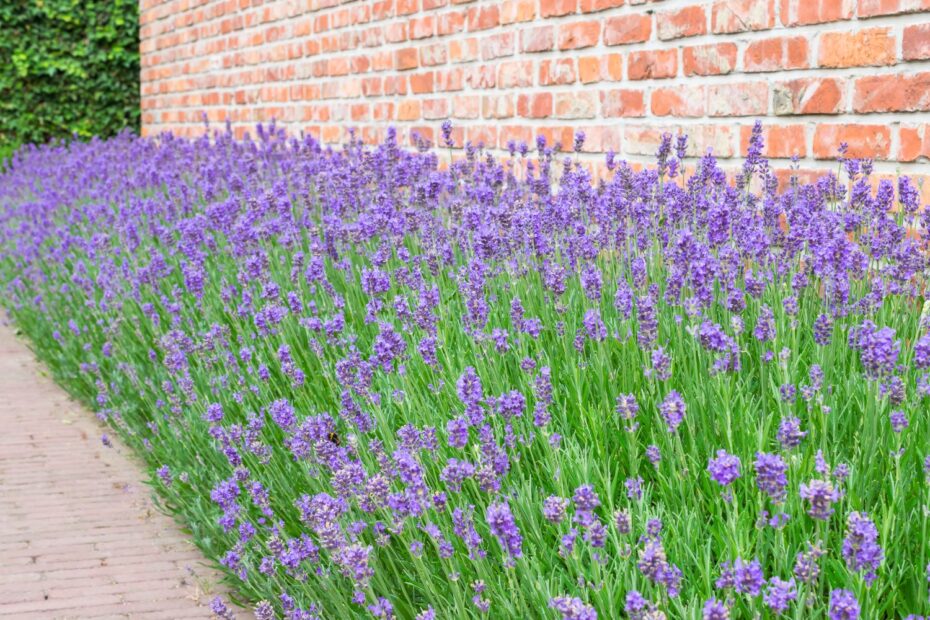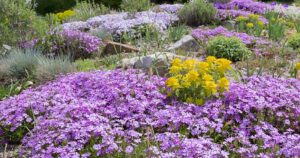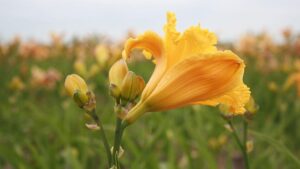Lavender Blooming: All Summer Long or Not?
Lavender is a popular herb that is known for its sweet scent and calming properties. It is also a beautiful flower that can add color to any garden. But when does lavender bloom? Is it all summer long, or does it have a more specific blooming period?
In this article, we will explore the blooming period of lavender. We will also discuss the different factors that affect when lavender blooms, and how to extend the blooming period of your lavender plants.

So, if you’re curious about when lavender blooms, or if you’re looking for ways to extend the blooming period of your lavender plants, read on!
Lavender Blooms: When and for How Long?
Lavender Blooms: When and for How Long?
Lavender is a beautiful and fragrant flower that blooms in the summer months. The exact timing of the bloom depends on the variety of lavender, but most varieties bloom in June or July. The blooms typically last for about two to three weeks, but they can sometimes last longer in cooler climates.
Lavender blooms are a popular addition to gardens and bouquets, and they are also used in a variety of products, such as essential oils, soaps, and candles. The flowers are also edible and can be used in a variety of recipes.
If you are looking to grow lavender in your garden, it is important to choose a variety that is suited for your climate. Lavender is a drought-tolerant plant, but it does need full sun to bloom well.
Lavender Bloom Timeline
- June: Lavender blooms begin to appear in warmer climates.
- July: Lavender blooms reach their peak in most climates.
- August: Lavender blooms begin to fade in warmer climates.
- September: Lavender blooms can still be found in cooler climates.
Tips for Growing Lavender
- Choose a variety of lavender that is suited for your climate.
- Plant lavender in full sun.
- Water lavender regularly, but do not overwater.
- Fertilize lavender once a year in the spring.
- Deadhead lavender regularly to encourage new blooms.
Lavender Uses
- Lavender flowers can be used in a variety of recipes, such as tea, lemonade, and desserts.
- Lavender essential oil is used in a variety of products, such as soaps, lotions, and candles.
- Lavender is also used in aromatherapy to promote relaxation and reduce stress.
The Science of Lavender Blooms
The Science of Lavender Blooms
Lavender is a popular herb that is known for its calming scent and beautiful purple flowers. But did you know that there is a science behind lavender blooms?
- The lavender plant produces flowers in the summer months. The blooms typically appear in June or July and last for several weeks.
- The number of lavender blooms depends on the variety of plant. Some varieties produce more blooms than others.
- The size of the lavender blooms also varies depending on the variety. Some blooms are small and delicate, while others are large and showy.
- The color of the lavender blooms can range from light purple to deep purple. Some varieties also produce white or pink blooms.
- The fragrance of lavender blooms is one of the most distinctive features of the plant. The scent is often described as calming and relaxing.
Lavender blooms are a beautiful addition to any garden. They are also a source of essential oil, which is used in a variety of products, including perfumes, soaps, and lotions.
| Factor | How it affects lavender blooms |
|---|---|
| Climate | Warmer climates produce more blooms, while cooler climates produce fewer blooms. |
| Soil | Lavender grows best in well-drained soil. |
| Water | Lavender needs regular watering, but it is important not to overwater the plant. |
| Fertilizer | Lavender does not need a lot of fertilizer. |
By understanding the science of lavender blooms, you can help your plants produce more beautiful flowers.
How to Get the Most Out of Lavender Blooms
How to Get the Most Out of Lavender Blooms
Lavender is a beautiful and fragrant herb that blooms in the summer months. If you’re lucky enough to have a lavender plant in your garden, you can enjoy its blooms for months to come by following these tips:
- Harvesting lavender blooms at the right time. The best time to harvest lavender blooms is when they are just starting to open. This is usually in late June or early July. To harvest the blooms, cut the stems just below the flower head.
- Drying lavender blooms. Once you’ve harvested the blooms, you need to dry them so that you can enjoy their fragrance all year long. The best way to dry lavender blooms is to hang them upside down in a cool, dark place. The blooms should be dry within a few weeks.
- Using lavender blooms. There are many ways to use lavender blooms. You can add them to potpourris, sachets, and candles. You can also use them to make tea, syrup, and vinegar. Lavender is also a popular ingredient in essential oils and beauty products.
Here are some additional tips for getting the most out of lavender blooms:
- Plant lavender in a sunny spot. Lavender needs full sun to bloom properly.
- Water lavender regularly, but don’t overwater it. Lavender is drought-tolerant, but it will need more water during hot, dry spells.
- Fertilize lavender once a year in the spring. Use a fertilizer that is specifically designed for lavender.
- Prune lavender plants in the spring to encourage new growth. Prune the plants back by about one-third.
By following these tips, you can enjoy the beauty and fragrance of lavender blooms for months to come.
Tips for Growing Lavender in Your Garden
Tips for Growing Lavender in Your Garden
Lavender is a beautiful and fragrant herb that is easy to grow in your garden. It can be used in a variety of ways, including as an ornamental plant, a culinary herb, and a natural insect repellent.
Here are a few tips for growing lavender in your garden:
- Choose the right location. Lavender prefers full sun and well-drained soil. It can tolerate some drought, but it will do best if it is watered regularly.
- Plant lavender in the spring or early summer. Dig a hole that is twice the width of the root ball and deep enough so that the crown of the plant is level with the soil. Backfill the hole with soil and water well.
- Fertilize lavender once a year in the spring. Use a slow-release fertilizer that is specifically formulated for herbs.
- Prune lavender in the spring to remove dead or damaged stems. You can also prune lavender to shape it or to encourage new growth.
- Harvesting lavender is easy. Simply cut the stems just above a leaf node. The flowers can be used fresh or dried.
Lavender is a beautiful and versatile herb that can add a touch of elegance to any garden. With a little care, you can enjoy the beauty and fragrance of lavender for years to come.
Table of Lavender Varieties
| Variety | Bloom Time | Height | Fragrance | Hardiness |
|---|---|---|---|---|
| English Lavender | Late spring to early summer | 2-3 feet | Strong | USDA Zones 5-9 |
| French Lavender | Late spring to early summer | 2-3 feet | Sweet | USDA Zones 5-9 |
| Spanish Lavender | Late spring to early summer | 3-4 feet | Mild | USDA Zones 7-10 |
| Italian Lavender | Late spring to early summer | 1-2 feet | Strong | USDA Zones 5-9 |
| Lavandin | Late spring to early summer | 3-4 feet | Strong | USDA Zones 5-9 |
Lavender blooms are a versatile ingredient that can be used in a variety of recipes and for a variety of purposes. Here are a few of our favorites:
-
Edible Uses
- Lavender can be used to flavor tea, syrups, and other beverages.
- It can also be added to salads, desserts, and other dishes.
- Lavender honey is a delicious and fragrant addition to any breakfast spread.
-
Non-Edible Uses
- Lavender can be used to make potpourri, sachets, and other air fresheners.
- It can also be used to make essential oils, which have a variety of therapeutic benefits.
- Lavender can be used to repel insects, such as mosquitoes and flies.
Here is a table of some of the most common culinary and medicinal uses for lavender blooms:
| Use | Recipe | Benefits |
|---|---|---|
| Edible | Lavender tea | Soothes the stomach, helps with sleep, and reduces anxiety |
| Non-edible | Lavender sachet | Repels insects, freshens air |
| Medicinal | Lavender essential oil | Reduces inflammation, soothes skin, and promotes relaxation |
Lavender Blooms: A Beautiful and Versatile Ingredient
Lavender blooms are a beautiful and versatile ingredient that can be used in a variety of ways. Whether you’re looking for a delicious new way to enjoy lavender or you’re seeking out its therapeutic benefits, there are plenty of ways to incorporate this fragrant flower into your life.
Resources
# Additional Resources
- Lavender Bloom Time
- When Does Lavender Bloom?
Final Thoughts
Outro
Lavender is a beautiful and fragrant flower that blooms for a short period of time each year. But how long does lavender bloom for? The answer to that question depends on a few factors, including the variety of lavender, the climate, and the growing conditions.
In general, lavender blooms for about two to three months, from mid-summer to early fall. However, some varieties of lavender can bloom for up to four months, while others may only bloom for a few weeks. The climate also plays a role in how long lavender blooms for. In warm climates, lavender may bloom for a longer period of time than in cooler climates. And the growing conditions can also affect the length of lavender’s bloom time. Lavender that is grown in well-drained soil and full sun will typically bloom for a longer period of time than lavender that is grown in poor soil or partial shade.
So, if you’re looking for a flower that will bloom all summer long, lavender may not be the best choice. But if you’re willing to wait a few months for a beautiful display of flowers, lavender is a great option.
If you’re interested in learning more about lavender, be sure to check out our article on the different varieties of lavender and how to grow them. And if you’re ready to add some lavender to your garden, be sure to visit your local nursery or garden center.
- Cat Palm vs Majesty Palm: Which Should You Choose? - June 30, 2024
- Flowers That Survive Winter: Discover the Exceptional No. 5 - June 30, 2024
- The Ultimate Guide to the Growth and Care of the Black Pagoda Lipstick Plant - June 29, 2024


